The hummingbirds in South Carolina are tiny wonders that capture our hearts with their colors and lightning-fast wing movements. They not only brighten up our surroundings but also help in keeping our world beautiful by pollinating flowers. In this article, we will get to know 10 different types of hummingbirds found in South Carolina. We’ll also discuss the flowers they are most attracted to.
Types of Hummingbirds in South Carolina
South Carolina is home to 10 different hummingbird species that have been observed over the years. Among them, state checklists acknowledge 2 species as commonly found, while 8 others are deemed to be infrequent or unexpected. And one of these birds is classified as near-threatened. Now, let’s take a closer look at these species of hummingbirds that you can find in South Carolina.
1. Ruby-Throated Hummingbird (Archilochus colubris)
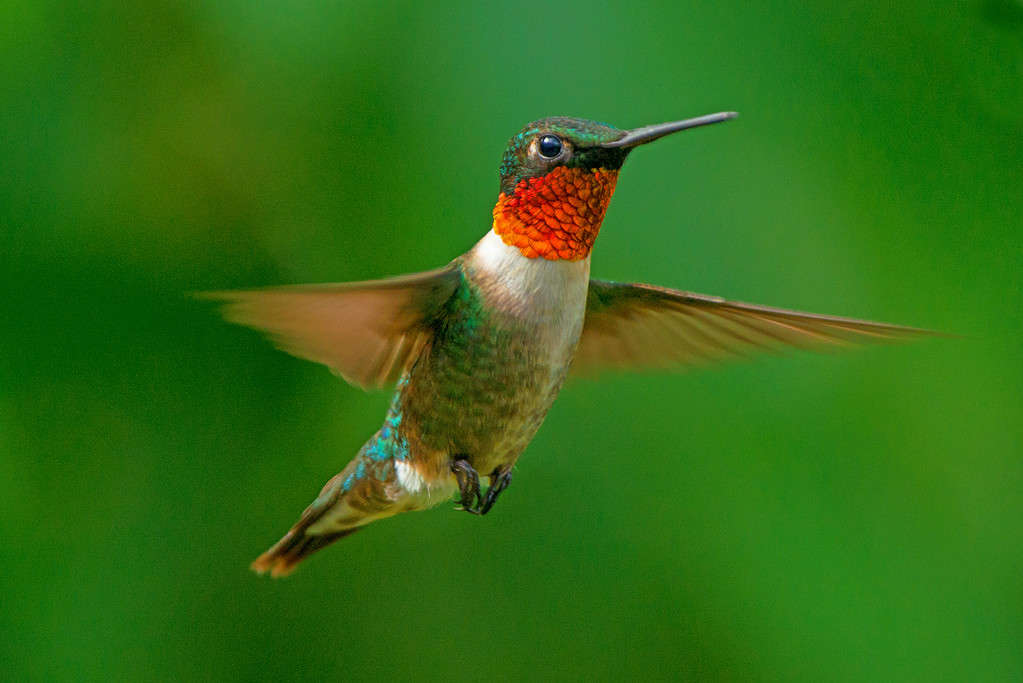
Ruby-throated hummingbirds are one of two hummingbirds that you can frequently see in South Carolina.
©CarolinaBirdman/iStock via Getty Images
The back and crown of the ruby-throated hummingbird shine in bright emerald or golden-green hues, while its underparts are grayish-white in color. The males are distinct with their dazzling red throats, which may appear dark if the lighting is not favorable.
This species is unique as it is the sole hummingbird species that breeds in the eastern region of North America. Measuring 3 to 4 inches in both length and wingspan, the ruby-throated hummingbird flaps its wings astonishingly over 50 times in a single second.
During the summer, the ruby-throated hummingbird is the only hummingbird in South Carolina. They stay in the state for the breeding season from April to November before a majority migrates south for the winter. However, a few may decide to stay throughout the year.
In the summertime, they are mostly found in flowering gardens or at the edges of woodlands. Surprisingly, they are also frequently seen in urban areas, particularly near nectar feeders.
2. Rufous Hummingbird (Selasphorus rufus)
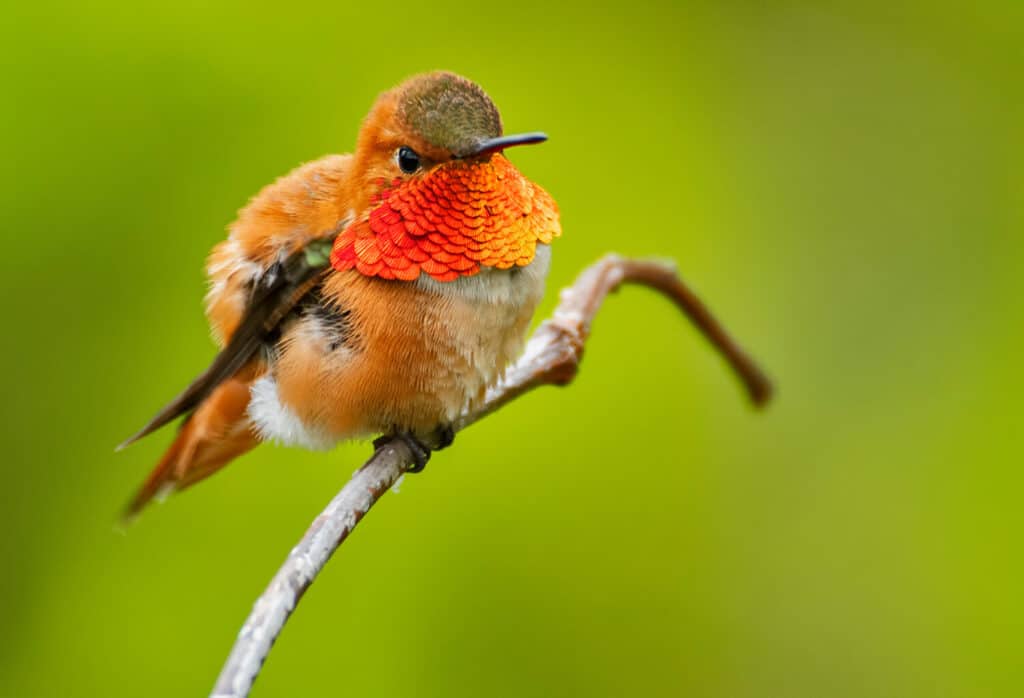
Rufous hummingbirds are orange in color, as evidenced by their name.
©punkbirdr/Shutterstock.com
This small hummingbird has an almost straight bill, a pointed tail when folded, and relatively short wings that don’t reach the tail’s end when perched. Male rufous hummingbirds exhibit a bright orange hue on their back and belly, coupled with a striking iridescent red throat.
Just over three inches in length, the rufous hummingbird is quite the fierce little fighter. It boldly confronts birds much larger than itself, as well as sizable insects or any other potential threats to its territory.
Remarkably, the rufous hummingbird is one of the champions of migration in relation to its size. It covers distances up to 4,000 miles each way. During the summer, they breed in Canada and the northwestern regions of Alaska. Then, they migrate to the Gulf Coast and Mexico for the winter.
Although classified as a near-threatened species in South Carolina, the rufous hummingbird has been observed in the state during the colder months, from August until early April.
3. Black-Chinned Hummingbird (Archilochus alexandri)

Black-chinned hummingbirds have a black throat with a purple shimmer that catches the light beautifully.
©rck_953/Shutterstock.com
The upper part of this hummingbird is a metallic green, while the lower part is a dull grayish-white. Male black-chinned hummingbirds boast a velvety black throat with a fine, shimmering purple base, whereas females have a light-colored throat. For both genders, the sides are a dull metallic green. The female’s three outermost tail feathers display broad white ends.
Measuring 3.25 to 3.5 inches in length, the black-chinned hummingbird’s heart races at 1,260 beats per minute during flight and slows to around 480 beats per minute when at rest. On top of such a rapid heart rate, the wings of the black-chinned hummingbird flutter at 70 times per second, creating a humming noise as they fly.
While the black-chinned hummingbird is an accidental species in South Carolina, it is sporadically seen in the winter. Black-chinned hummingbirds can be spotted perching at the top of dead trees on small, bare branches, and they often revisit a preferred perch.
4. Buff-Bellied Hummingbird (Amazilia yucatanensis)
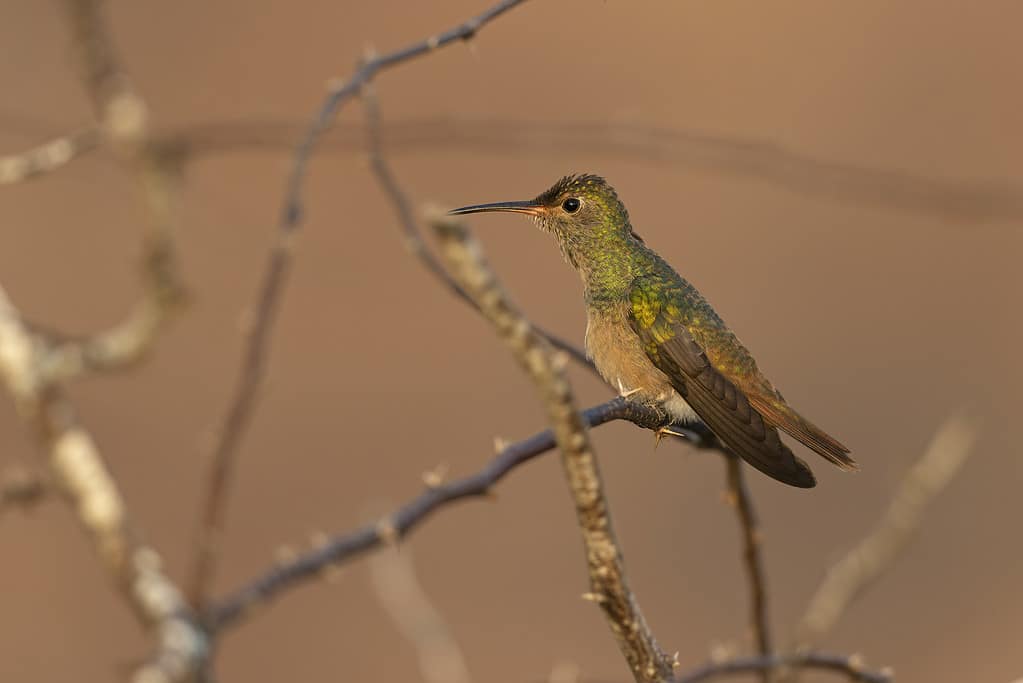
A hummingbird you might be lucky to spot in South Carolina is the buff-bellied hummingbird.
©BoukeAtema/iStock via Getty Images
The adult buff-bellied hummingbird displays a bronze-green upper part, a buff-colored belly, a blue-green throat and chest (which appears gray in the absence of sunlight), a rufous tail, and a noticeable red bill with a dark tip.
Measuring between 3.9 to 4.3 inches in length, the buff-bellied hummingbird is the sole representative of its genus in the United States, while all its relatives are indigenous to Honduras, Mexico, Guatemala, and other regions of Central America.
The buff-bellied hummingbird is an accidental or uncommon species in South Carolina. But there have been sightings during the winter. They are particularly drawn to areas with abundant greenery and a diversity of plants. Suburban residences with expansive landscaping and gardens are especially appealing to the buff-bellied hummingbird.
5. Calliope Hummingbird (Selasphorus calliope)
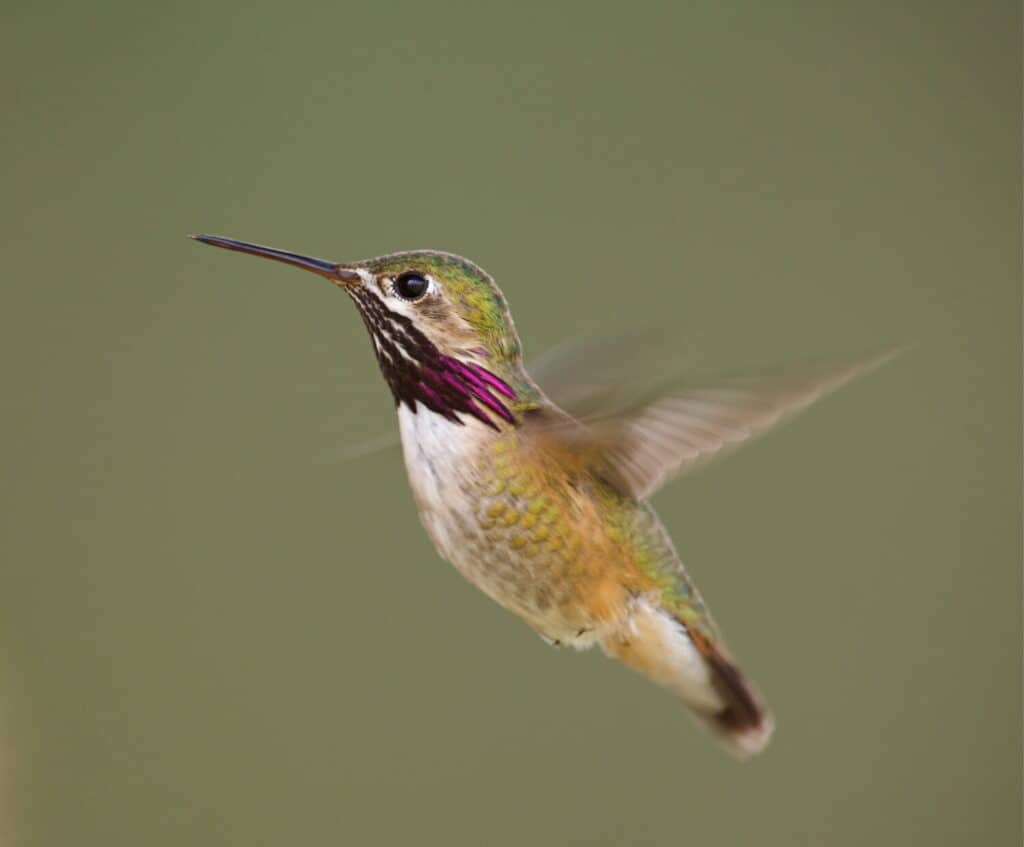
The male calliope hummingbird has a striking magenta streak on its throat.
©Tom Reichner/Shutterstock.com
The most distinguishing characteristic of a calliope hummingbird is the magenta streaks on the male’s throat. Both genders exhibit a greenish hue above. However, males have a greenish tint below, while females and young birds exhibit a peachy undertone across their lower parts.
Being the smallest bird in North America, it measures around 3 inches in length and weighs approximately one-tenth of an ounce. This tiny hummingbird holds the record for being the smallest long-distance migrant globally. It covers roughly 5,000 miles annually between its breeding and wintering habitats.
Although calliope hummingbirds are uncommon along the eastern coast, there have been sporadic sightings around Columbia and Charleston in South Carolina. To spot a calliope hummingbird, one strategy is to locate its preferred perch within its breeding territory. Typically, their chosen perch is a bare twig protruding from a willow or alder tree.
6. Anna’s Hummingbird (Calypte anna)

One of the more colorful hummingbirds in South Carolina is Anna’s hummingbird.
©yhelfman/Shutterstock.com
Anna’s hummingbirds predominantly have green and gray plumage, devoid of any rufous or orange markings. The males display iridescent reddish-pink feathers on their head and throat, which can appear brownish or gray in the absence of direct sunlight.
These birds measure approximately 4 inches in length. Remarkably, Anna’s hummingbirds can vibrate their bodies at a rate of 55 times per second to dispel raindrops during flight or, in dry conditions, to remove pollen or dirt from their feathers. The heart of Anna’s hummingbird pulsates at a staggering rate of around 1,260 beats per minute.
Although extremely rare in South Carolina, they were sighted near Berkeley in 2010. Typical habitats for Anna’s hummingbirds include backyards and parks adorned with vibrant flowers and nectar dispensers, but they are also encountered in scrublands and savannahs.
7. Broad-Tailed Hummingbird (Selasphorus platycercus)

Broad-tailed hummingbirds have a shimmering green back, a white ring around the eyes, and a black tail.
©Kati Fleming / CC BY-SA 3.0 – License
The adult broad-tailed hummingbird features a shimmering green back, a white ring around its eyes, and a rounded black tail that extends beyond its wingtips, which inspired its name. Males have a distinct rose-red throat patch. Females can be identified by their lighter colors, cinnamon-colored sides, and speckled cheeks, traits not present in males.
At a medium size of about 4 inches, the broad-tailed hummingbird is notable for its nesting behavior. During the nesting season, female broad-tailed hummingbirds may steal nest materials from one another for their own nest construction.
To cope with colder temperatures at higher altitudes, broad-tailed hummingbirds have the ability to reduce their heart rate and lower their body temperature, entering a state of torpor. Although classified as rare visitors in South Carolina, there was a recorded sighting of broad-tailed hummingbirds at the Hilton Pond Center for Piedmont Natural History in 2021.
8. Broad-Billed Hummingbird (Cynanthus latirostris)

A super vibrant hummingbird, the broad-billed hummingbird has a metallic green hue and a straight bill.
©Monir Hossain/iStock via Getty Images
The broad-billed hummingbird is arguably the most vibrant hummingbird in the United States. It boasts a radiant metallic green hue and a straight, slim bill that is red with a black tip. The males exhibit a brilliant blue throat, whereas the females have a white stripe running across their eyes.
These birds average a length ranging from 3.25 to 4 inches. To sustain themselves, broad-billed hummingbirds consume nectar daily, approximately 1.6 to 1.7 times their body weight. During courtship, a male broad-billed hummingbird performs a captivating display by hovering about a foot away from the female before moving back and forth in a pendulum-like motion.
Though a rare species in South Carolina, there are records of broad-billed hummingbird sightings in Rockville in 2008. These birds prefer foraging in canyon streams and mountain meadows, but they are also known to frequent backyard feeders.
9. Allen’s Hummingbird (Selasphorus sasin)
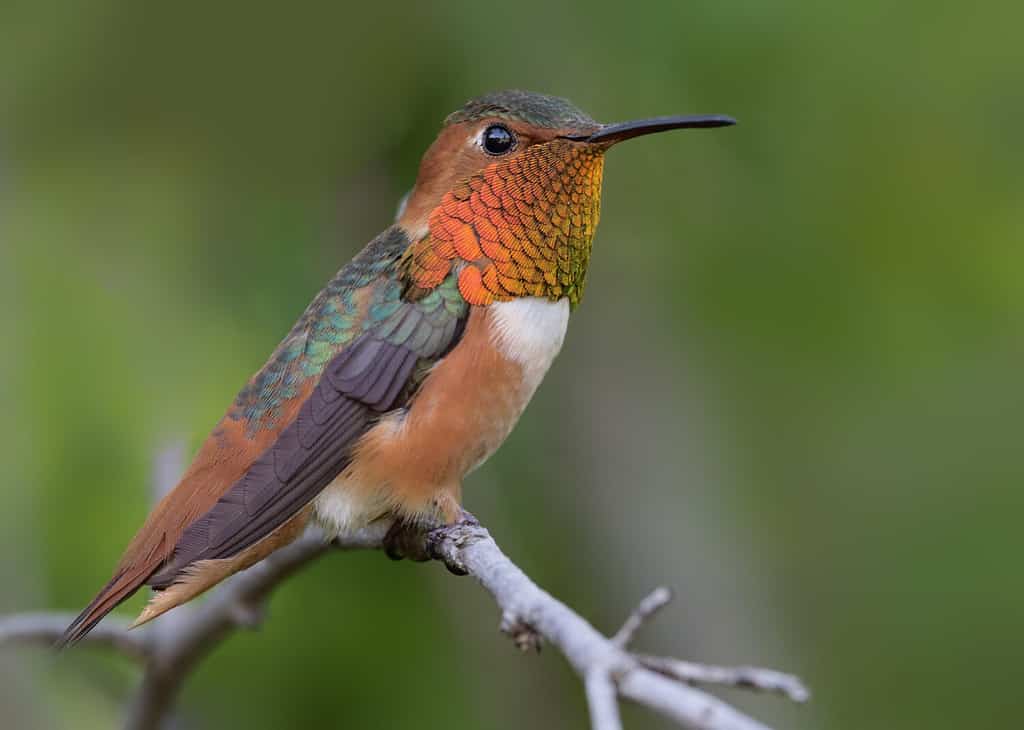
The Allen’s hummingbird is one of the smallest birds, measuring just 3 to 3.5 inches long.
©Angel DiBilio/Shutterstock.com
The male Allen’s hummingbird sports a vibrant red-orange throat, a white ring around its neck, and a metallic green color on its back and head. In contrast, the female has a green upper body, orange-brown sides and tail, and a white throat and central belly adorned with shimmering dots.
As one of the tiniest bird species, Allen’s hummingbirds measure only between 3 to 3.5 inches in length. Despite their size, they are fiercely territorial. Male Allen’s hummingbirds will not hesitate to chase away other males or even different hummingbird species from their territory. Remarkably, they have also been observed attacking and driving away predatory birds, such as kestrels and hawks.
Although Allen’s hummingbirds are not common in South Carolina, there was a recorded sighting in Lexington in 2008. These hummingbirds typically inhabit areas with dense vegetation, such as bushy woods, flower-filled mountain meadows, gardens, and parks.
10. Blue-Throated Mountaingem (Lampornis clemenciae)

Blue-throated mountaingems can flap their wings up to 23 times per second.
©hstiver/iStock via Getty Images
Adult male blue-throated mountaingems have a bronze-green back, white lines above and below their eyes, and a sparkling blue throat, which can sometimes appear dark in low light. Their underside is gray, and their blackish tail feathers have white tips. The females and juveniles resemble the males but do not have the blue throat.
Being the largest hummingbird species found in the United States, the blue-throated mountaingem measures between 4.4 to 5 inches in length. Unlike smaller hummingbirds like the rufous hummingbird, which can flap its wings up to 62 times per second, the blue-throated mountaingem flaps its wings up to 23 times per second while hovering.
Although it is incredibly rare to spot blue-throated mountaingems in South Carolina, the South Carolina Bird Records Committee has accepted a few recorded sightings of the species in the state. So, if you are lucky, you might spot a blue-throated mountaingem visiting a sugar-water feeder or a hummingbird garden in your backyard.
Plants in South Carolina That Attract Hummingbirds
Attracting hummingbirds into your South Carolina garden is as simple as choosing the right plants. Discover which plants in South Carolina can transform your garden into a hummingbird haven.
1. Canadian Columbine (Aquilegia canadensis)
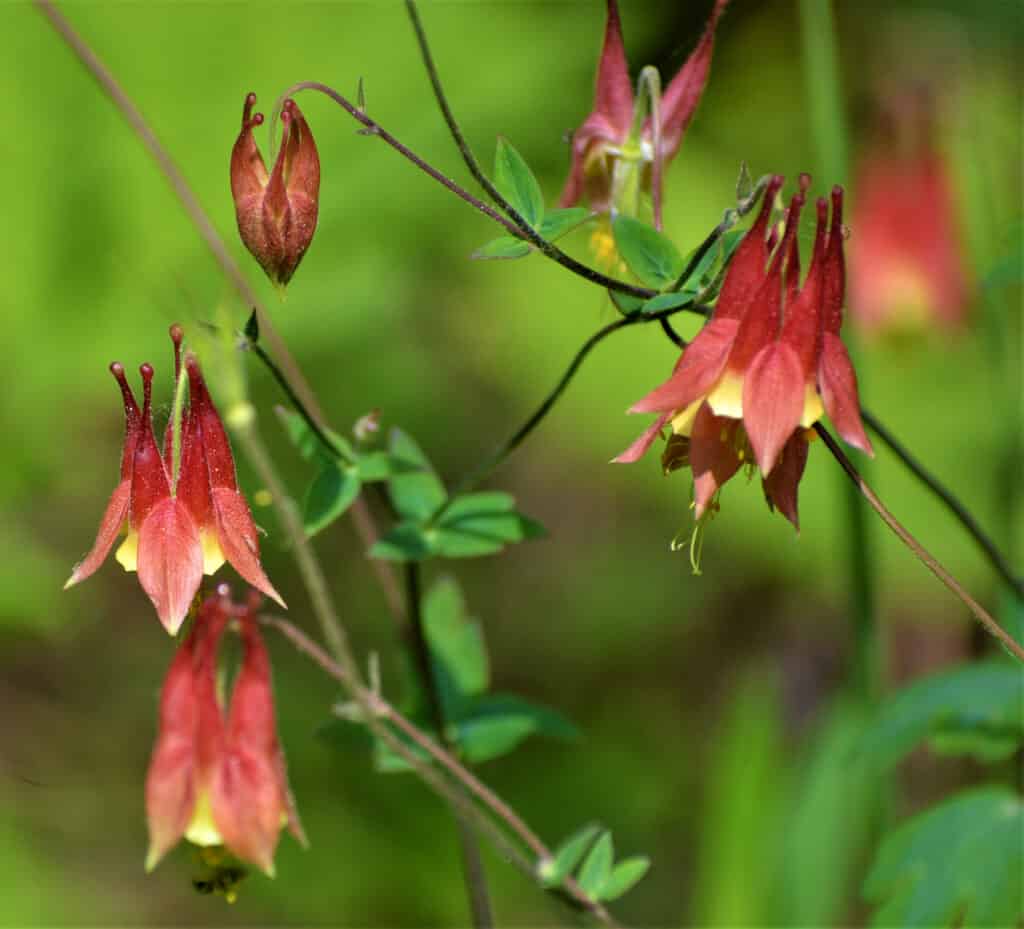
A native plant to South Carolina, the Canadian columbine attracts hummingbirds with its nectar.
©akslocum/Shutterstock.com
The Canadian columbine, a native to the woodlands and rocky slopes of eastern North America, including South Carolina, is an award-winning plant known for its unique, 2-inch-wide flowers with long spurs, scarlet sepals, pale yellow petals, and bushy yellow stamens.
Flowering from late spring to early summer, it forms a dense, upright clump, growing up to 2-3 feet tall. It thrives best in a mix of full sun and partial shade with well-drained, medium-moisture soil.
The long spurs of the Canadian columbine are actually elongated nectaries filled with sweet nectar, which attract a variety of pollinators, from hummingbirds to bees with long tongues to hawkmoths.
2. Crossvine (Bignonia capreolata)
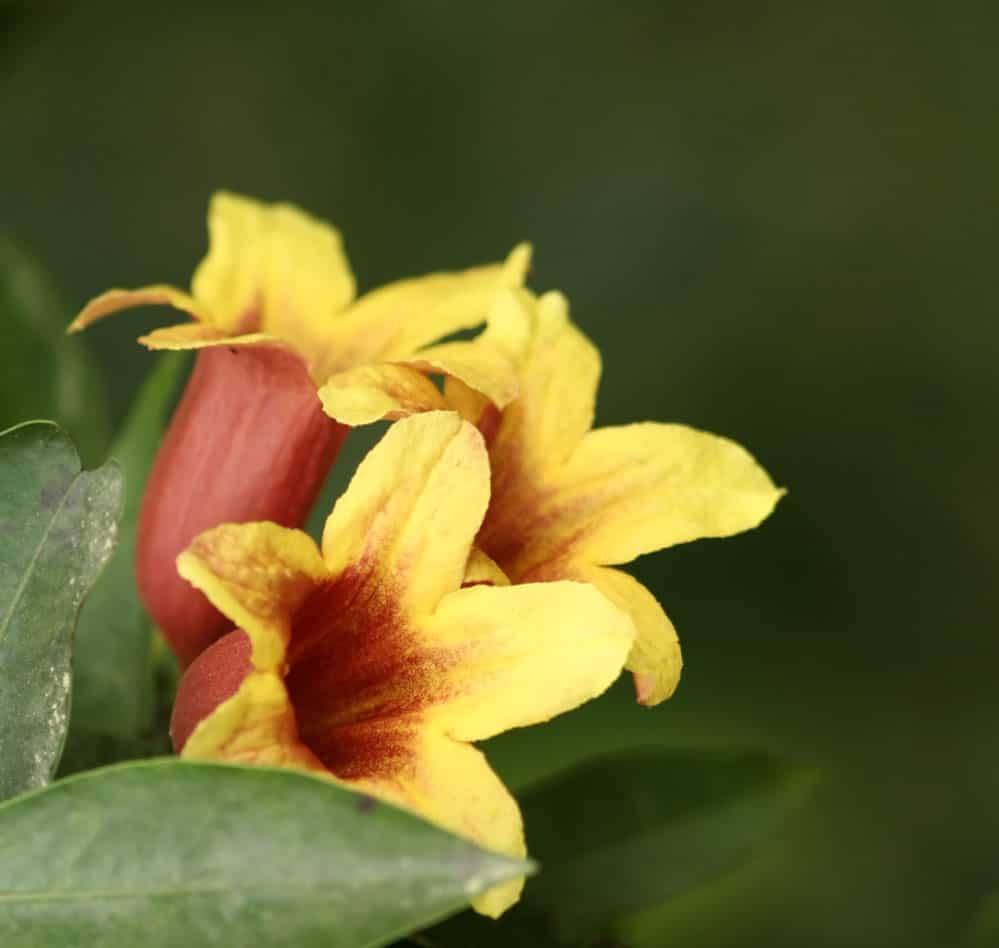
Crossvines are hummingbird magnets, thanks to their trumpet-shaped colorful flowers.
©iStock.com/Dewitt
Another native plant of South Carolina that is a hummingbird magnet is the crossvine. This woody vine is not only fast-growing and self-clinging but also boasts a multitude of fragrant, trumpet-shaped flowers that are 2 inches long and come in vibrant shades of orange, yellow, or red. Known as one of the most flower-abundant vining plants, it is almost entirely covered in large clusters of 2 to 5 colorful blossoms during mid-spring, although there are occasional blooms in summer as well.
This particular vine is relatively easy to grow and capable of growing quickly to 30 to 50 feet long. It flourishes in organically rich, well-drained soils and can tolerate both full sun and partial shade.
Hummingbirds are particularly drawn to the nectar of these flowers and are regular visitors.
3. Trumpet Vine (Campsis radicans)
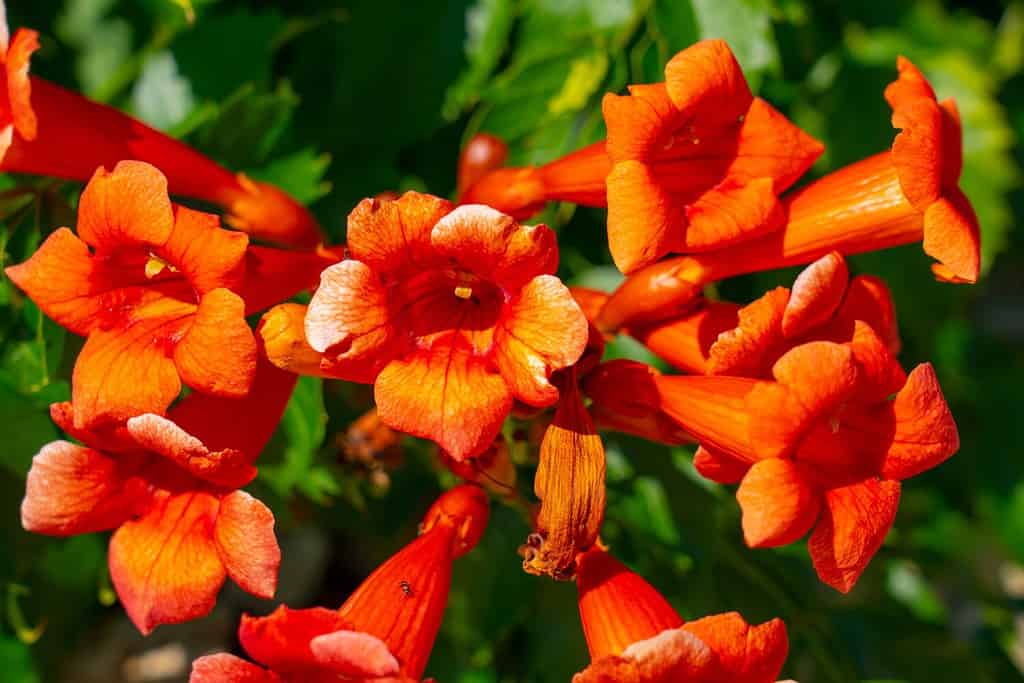
Of course, one of the best flowers to plant in South Carolina to attract hummingbirds is the trumpet vine.
©martin.dlugo/Shutterstock.com
The trumpet vine, native to North America, is a robust, self-attaching woody climber that showcases especially striking trumpet-shaped flowers. These 3-inch-long blooms, in vivid shades of orange or red, make their appearance all summer long. Gathered in clusters at the branch tips, they create a spectacular and enduring floral show.
This plant is not only hardy and simple to cultivate but also incredibly floriferous, capable of rapidly reaching between 20 to 40 feet long. It prefers lean to average, moist, well-drained soils and can thrive in both full sun and partial shade.
Hummingbirds are particularly fond of trumpet vines due to the bloom’s shape, which fits the birds’ lengthy tongues perfectly. Although the mechanism was a mystery for a long time, recent research has revealed that the birds’ tongues function like efficient miniature pumps.
4. Fringed Bleeding Heart (Dicentra eximia)
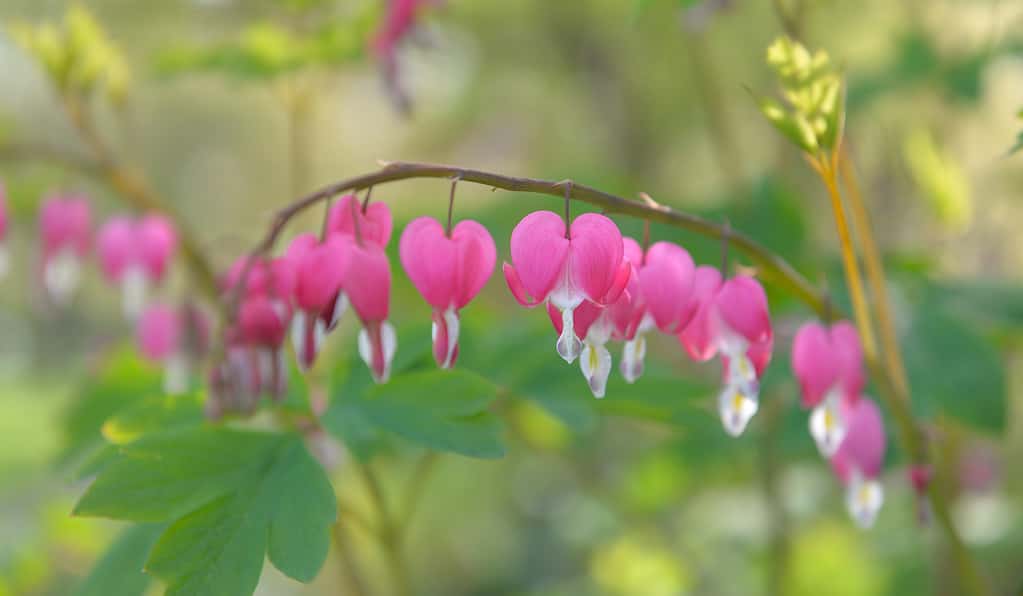
A native plant to South Carolina, the fringed bleeding heart attracts hummingbirds with its nectar.
©sanddebeautheil/iStock via Getty Images
The fringed bleeding heart is a native plant of the eastern United States and is a compact, bushy perennial. It produces small rose-pink buds in clusters that open into pale to dark pink, nodding, heart-shaped flowers. These flowers elegantly sway above the mound of lush foliage and bloom from early spring until frost. However, flowering may cease during the summer heat, especially in hotter climates, and possibly resume in late summer or early fall.
This plant typically reaches a height and width of 12 to 18 inches. It thrives in partially shaded areas and grows best in fertile, humus-rich, moist, and well-drained soils.
Hummingbirds are attracted to the fringed bleeding heart because of the nectar it provides, making it a perfect plant for attracting these birds to South Carolina gardens.
5. Cardinal Flower (Lobelia cardinalis)
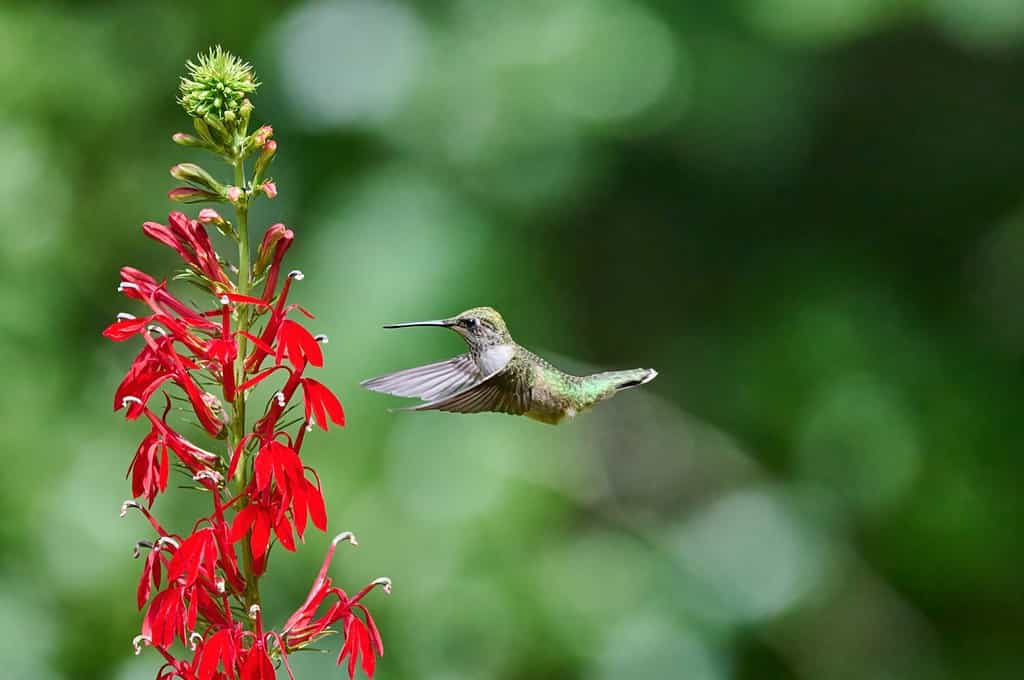
One of the most famous plants that attracts hummingbirds in South Carolina is the cardinal flower.
©Patrick Jennings/Shutterstock.com
The cardinal flower is a well-liked perennial that forms upright clumps and is perfect for brightening up the garden in late summer. It produces a multitude of flower spikes filled with dazzling, cardinal red, two-lipped blossoms, each about 2 inches long, from midsummer to the beginning of fall.
This plant typically grows to a height of 2 to 4 feet and a width of 1 to 2 feet. It thrives in rich, medium to wet soils and prefers full sun to partial shade. It benefits from some protection from the hot afternoon sun and requires a lot of moisture. Interestingly, it can also be grown in water up to 3 inches deep.
The red tubular flowers of the cardinal flower are designed to catch the eye of hummingbirds. Each flower is intricately structured to maximize the benefits of a hummingbird’s visit. As the bird reaches for the nectar, the anther, which is the part of the male flower that produces pollen, brushes against the bird’s head, facilitating pollination.
Where to See Hummingbirds in South Carolina
The ruby-throated hummingbird, the most prevalent species along the Atlantic Coast, is often spotted at coastal state parks and beaches. Notable locations for sightings include Hunting Island State Park and Caeser’s Head State Park.
The rufous hummingbird occasionally makes its way to South Carolina during the winter months and can be seen in gardens, particularly near feeders.
Although there are technically eight other species of hummingbirds in South Carolina, they are infrequently seen and do not visit regularly, which makes it difficult to determine where one might catch a glimpse of these unpredictable guests.
Creating gardens in your backyard with bright, nectar-rich flowers and setting up hummingbird feeders is one of the most effective ways to spot hummingbirds in South Carolina. Hummingbirds are attracted to the nectar in flowers and feeders and also appreciate having fresh water available.
Therefore, providing these in your garden will encourage them to visit, giving you a great opportunity to observe these fascinating creatures up close, right in your own backyard. This is not only a delightful experience but also a way to support these birds during their migratory journeys.
Summary of Hummingbirds in South Carolina
| Number | Hummingbird | Scientific Name |
|---|---|---|
| 1 | Ruby-throated Hummingbird | Archilochus colubris |
| 2 | Rufous Hummingbird | Selasphorus rufus |
| 3 | Black-chinned Hummingbird | Archilochus alexandri |
| 4 | Buff-bellied Hummingbird | Amazilia yucatanensis |
| 5 | Calliope Hummingbird | Selasphorus calliope |
| 6 | Anna’s Hummingbird | Calypte anna |
| 7 | Broad-tailed Hummingbird | Selasphorus platycercus |
| 8 | Broad-billed Hummingbird | Cynanthus latirostris |
| 9 | Allen’s Hummingbird | Selasphorus sasin |
| 10 | Blue-throated Mountain-gem | Lampornis clemenciae |
The photo featured at the top of this post is © Tom Reichner/Shutterstock.com
Thank you for reading! Have some feedback for us? Contact the AZ Animals editorial team.






